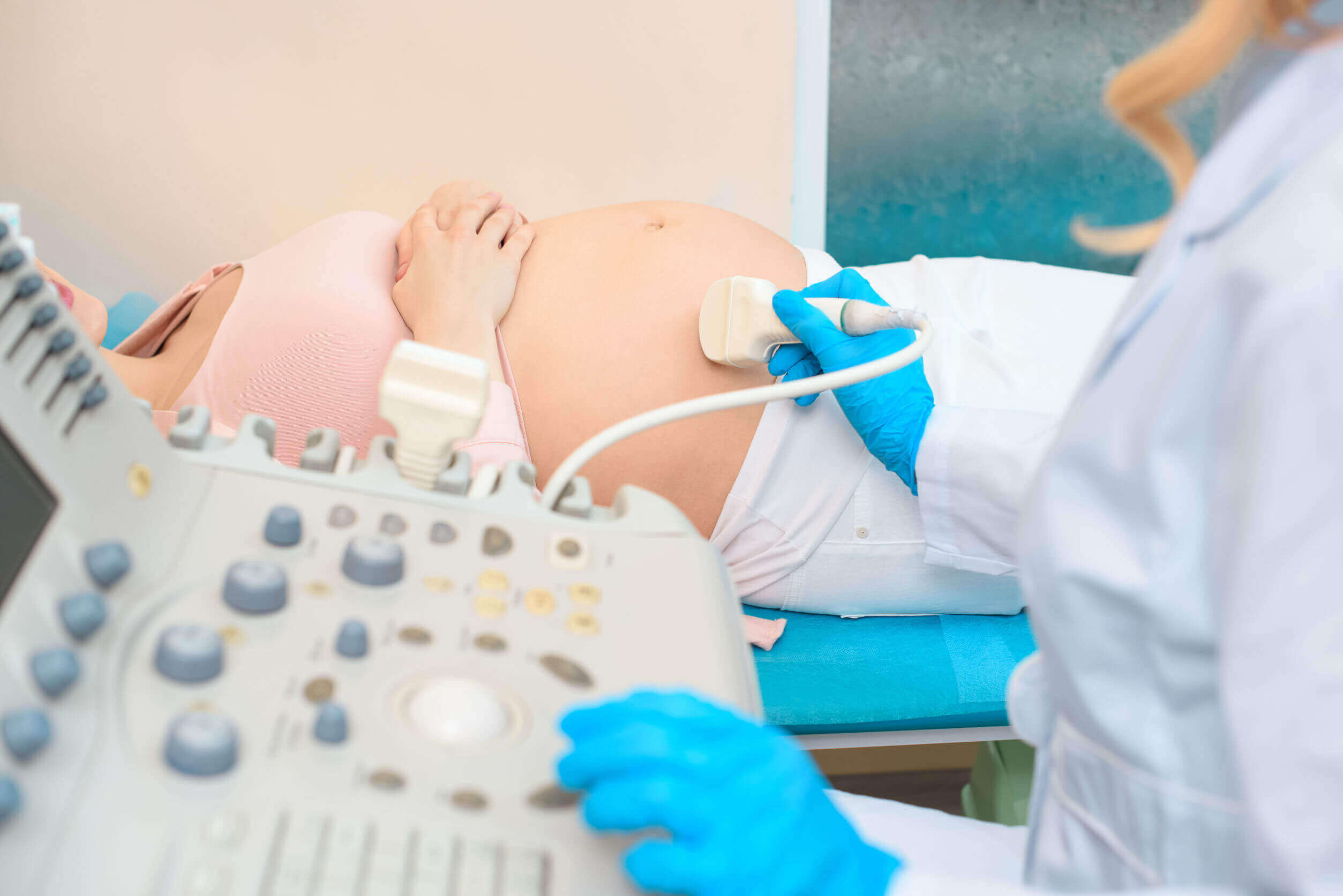Week 36 of Pregnancy: What You Should Know

You’ve reached week 36 of pregnancy! Anxiety increases, you start rushing to prepare, the family is very excited, and you just want to see your baby in your arms. At this stage, the baby is practically ready to come out!
There are some symptoms that you should be aware of because they require immediate medical attention. We don’t want any problems in the future! If you want to learn more about this and other aspects, we’ll tell you all about it in this article. Keep reading!
What is my baby like at week 36?

Welcome to the last days of pregnancy! Although a birth at this time is considered premature, it only takes a week until the baby is full term. At this time, they should measure about 14.5 inches and weigh about 6.2 pounds. It’s amazing how much they’ve grown!
Since they’re big for your uterus, it should already be in a cephalic position with their head towards your pelvis. Some babies may not be in this position yet, so some obstetricians recommend moving to help change their position. That’s why it’s so important to see your doctor before delivery!
Their organs are almost ready for the outside world. This includes the respiratory system, whose surfactant levels within the alveoli should already be at optimal values. Also, the nervous system should be ready, and the baby may even recognize your voice.
The bones in the skull are already well formed and ready to overlap while passing through the birth canal. Don’t be surprised if you see a small deformity in the skull just after birth! This usually improves within a few hours.
How will I feel during week 36 of pregnancy?
You’re most likely experiencing the same symptoms that have been bothering you so much this last semester of pregnancy. These include low back pain, nausea, anxiety and insomnia. In addition, it’s normal for contractions to become more and more frequent.
Since you’re close to the birth of your baby, it’s more common in week 36 of pregnancy to notice symptoms of urinary tract infections (UTI). These cause pain and burning when urinating, sometimes accompanied by a fever.
If this happens, you should see a doctor immediately: the effects of a UTI can trigger labor when you least expect it. Additionally, it can even have negative consequences on your baby. Let’s avoid going through this!
Find out more: The Mucus Plug During Pregnancy: 5 Questions and Answers
Is it necessary to go to the doctor?

Yes. Your obstetrician has probably scheduled a prenatal visit for this week or the next. If you had any routine exams, you should take them to your appointment to ask your doctor if you have any questions. Usually, these types of tests are:
- Complete blood count
- Blood test
- Urine sample
- HIV and VDRL tests
- Blood coagulation tests (PT and PTT)
- Ultrasound
If you’ve ever had surgery, you might find that these tests are very similar to preoperative tests. This is because if there’s an emergency that requires a cesarean section, the surgeon will have all the information they need.
That way, they can help prevent complications and know what to expect. Prenatal consultations continue until the baby is born, and you shouldn’t miss any.
What if my baby is born this week?
In the previous section, we told you that your child is already well developed under normal conditions. If your baby is born this week, it would still be considered a premature delivery. However, the chances of complications are small, but they do exist.
The most obvious consequence is that they can be born with low weight and height. In some cases, they’ll need to be hospitalized in the NICU for a few days. Because of this, it’s also a good idea to have a hospital bag ready in case you go into labor early.
Keep reading: How Can You Tell If You’re in Labor?
Frequently asked questions about week 36 of pregnancy
We know that you’re probably getting more nervous, which is why we’ll answer some of the most common questions during this week.
1. What is a mucous plug?
It’s an abundant discharge with a greenish, whitish or yellowish color that can sometimes be accompanied by blood. This substance is found along the cervix, and its expulsion is related to the start of labor.
However, this doesn’t mean that you’re about to have your baby! It will still take several hours for the cervix to dilate, especially if you’re a new mother. Then, when your water breaks, you should go to the hospital.

2. What is a premature rupture of membranes?
When the layers that make up the amniotic sac break prematurely and the fluid inside releases, this is a premature rupture of membranes. If this happens during week 36, you should go to the doctor as soon as possible. You may need medication to prevent it from affecting your baby.
3. Will I need a c-section?
This depends on your particular condition, but most cases don’t need a c-section. This surgical procedure tends to cause more complications than a natural childbirth, so it shouldn’t be the first option unless it’s medically necessary.
If you had a c-section before, have an active infection, or your baby has a disease or a genetic defect, your doctor may have a planned c-section for you.
Take advantage of these moments
Time is ticking, so make the most of it! Spend some quality time with your partner, family and friends, and don’t hesitate to notice all of the beautiful feelings that we know you’re expecting. Meanwhile, prepare your bag and the last things you need for your baby’s birth… Good luck!
You’ve reached week 36 of pregnancy! Anxiety increases, you start rushing to prepare, the family is very excited, and you just want to see your baby in your arms. At this stage, the baby is practically ready to come out!
There are some symptoms that you should be aware of because they require immediate medical attention. We don’t want any problems in the future! If you want to learn more about this and other aspects, we’ll tell you all about it in this article. Keep reading!
What is my baby like at week 36?

Welcome to the last days of pregnancy! Although a birth at this time is considered premature, it only takes a week until the baby is full term. At this time, they should measure about 14.5 inches and weigh about 6.2 pounds. It’s amazing how much they’ve grown!
Since they’re big for your uterus, it should already be in a cephalic position with their head towards your pelvis. Some babies may not be in this position yet, so some obstetricians recommend moving to help change their position. That’s why it’s so important to see your doctor before delivery!
Their organs are almost ready for the outside world. This includes the respiratory system, whose surfactant levels within the alveoli should already be at optimal values. Also, the nervous system should be ready, and the baby may even recognize your voice.
The bones in the skull are already well formed and ready to overlap while passing through the birth canal. Don’t be surprised if you see a small deformity in the skull just after birth! This usually improves within a few hours.
How will I feel during week 36 of pregnancy?
You’re most likely experiencing the same symptoms that have been bothering you so much this last semester of pregnancy. These include low back pain, nausea, anxiety and insomnia. In addition, it’s normal for contractions to become more and more frequent.
Since you’re close to the birth of your baby, it’s more common in week 36 of pregnancy to notice symptoms of urinary tract infections (UTI). These cause pain and burning when urinating, sometimes accompanied by a fever.
If this happens, you should see a doctor immediately: the effects of a UTI can trigger labor when you least expect it. Additionally, it can even have negative consequences on your baby. Let’s avoid going through this!
Find out more: The Mucus Plug During Pregnancy: 5 Questions and Answers
Is it necessary to go to the doctor?

Yes. Your obstetrician has probably scheduled a prenatal visit for this week or the next. If you had any routine exams, you should take them to your appointment to ask your doctor if you have any questions. Usually, these types of tests are:
- Complete blood count
- Blood test
- Urine sample
- HIV and VDRL tests
- Blood coagulation tests (PT and PTT)
- Ultrasound
If you’ve ever had surgery, you might find that these tests are very similar to preoperative tests. This is because if there’s an emergency that requires a cesarean section, the surgeon will have all the information they need.
That way, they can help prevent complications and know what to expect. Prenatal consultations continue until the baby is born, and you shouldn’t miss any.
What if my baby is born this week?
In the previous section, we told you that your child is already well developed under normal conditions. If your baby is born this week, it would still be considered a premature delivery. However, the chances of complications are small, but they do exist.
The most obvious consequence is that they can be born with low weight and height. In some cases, they’ll need to be hospitalized in the NICU for a few days. Because of this, it’s also a good idea to have a hospital bag ready in case you go into labor early.
Keep reading: How Can You Tell If You’re in Labor?
Frequently asked questions about week 36 of pregnancy
We know that you’re probably getting more nervous, which is why we’ll answer some of the most common questions during this week.
1. What is a mucous plug?
It’s an abundant discharge with a greenish, whitish or yellowish color that can sometimes be accompanied by blood. This substance is found along the cervix, and its expulsion is related to the start of labor.
However, this doesn’t mean that you’re about to have your baby! It will still take several hours for the cervix to dilate, especially if you’re a new mother. Then, when your water breaks, you should go to the hospital.

2. What is a premature rupture of membranes?
When the layers that make up the amniotic sac break prematurely and the fluid inside releases, this is a premature rupture of membranes. If this happens during week 36, you should go to the doctor as soon as possible. You may need medication to prevent it from affecting your baby.
3. Will I need a c-section?
This depends on your particular condition, but most cases don’t need a c-section. This surgical procedure tends to cause more complications than a natural childbirth, so it shouldn’t be the first option unless it’s medically necessary.
If you had a c-section before, have an active infection, or your baby has a disease or a genetic defect, your doctor may have a planned c-section for you.
Take advantage of these moments
Time is ticking, so make the most of it! Spend some quality time with your partner, family and friends, and don’t hesitate to notice all of the beautiful feelings that we know you’re expecting. Meanwhile, prepare your bag and the last things you need for your baby’s birth… Good luck!
All cited sources were thoroughly reviewed by our team to ensure their quality, reliability, currency, and validity. The bibliography of this article was considered reliable and of academic or scientific accuracy.
- MedlinePlus [Updated 2021 May 4]. Fetal development. Available from: https://medlineplus.gov/ency/article/002398.htm
- Verhave BL, Nassereddin A, Lappin SL. Embryology, Lanugo. [Updated 2021 May 8]. In: StatPearls [Internet]. Treasure Island (FL): StatPearls Publishing; 2021 Jan-. Available from: https://www.ncbi.nlm.nih.gov/books/NBK526092/
- Loh, K., & Sivalingam, N. (2007). Urinary tract infections in pregnancy. Malaysian family physician : the official journal of the Academy of Family Physicians of Malaysia, 2(2), 54–57.
- Becher, N., Adams Waldorf, K., Hein, M., & Uldbjerg, N. (2009). The cervical mucus plug: structured review of the literature. Acta obstetricia et gynecologica Scandinavica, 88(5), 502–513. https://doi.org/10.1080/00016340902852898
- Loftin, R. W., Habli, M., Snyder, C. C., Cormier, C. M., Lewis, D. F., & Defranco, E. A. (2010). Late preterm birth. Reviews in obstetrics & gynecology, 3(1), 10–19.
- Maldonado-Durán, M., Sauceda-García, J. M., Lartigue, T. (2008). Cambios fisiológicos y emocionales durante el embarazo normal y la conducta del feto. Perinatología y reproducción humana, 22, 5–14.
- Schapira, I. (2004). Características del desarrollo humano perinatal. Un método para la evaluación del sistema nervioso joven. Revista del Hospital Materno Infantil Ramón Sardá, 23(2), 59–69.
- Oncoy Rosales, Ariana. “Indicaciones de cesárea.” Rev. méd. panacea (2018): 69-73.
This text is provided for informational purposes only and does not replace consultation with a professional. If in doubt, consult your specialist.








